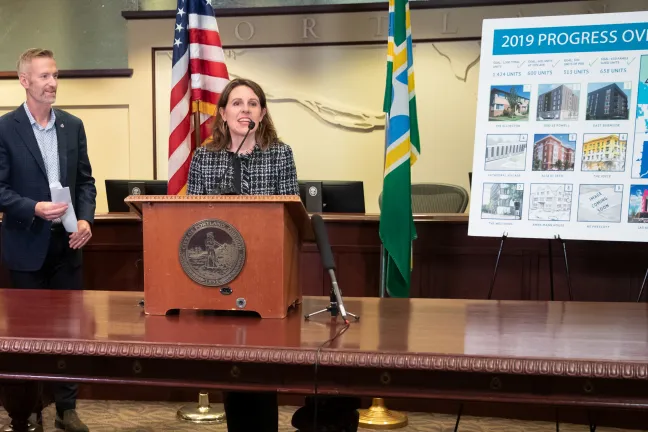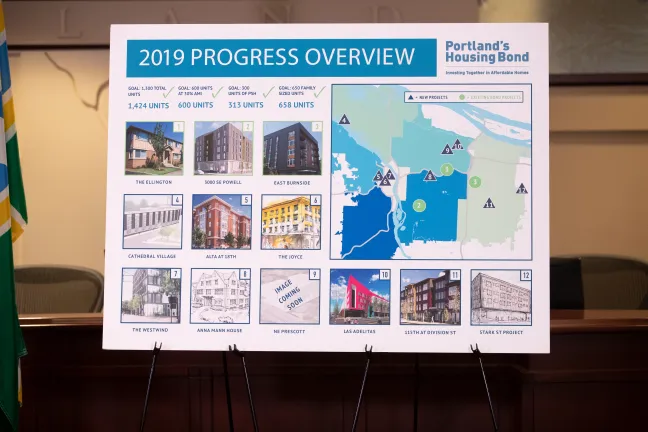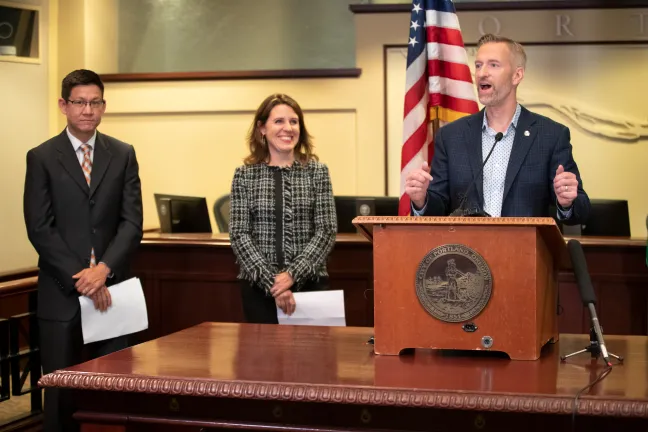Praising the power of partnerships, Chair Deborah Kafoury helped leaders from Portland and a phalanx of nonprofits announce hundreds of new affordable apartments on Sept. 17 while marking a major milestone for the city’s 2016 housing bond.
With funding now in place for nine new developments and wraparound social services — including contributions from the Joint Office of Homeless Services, regional tourism taxes and the sale of the old Wapato jail — every single bond goal has been met or exceeded.
Overall, some 1,424 apartments are either hosting people right now or will be soon, better than the 1,300 apartments promised by the bond campaign. The effort also will meet the targets for family-size apartments and units affordable for people with very low incomes.
That achievement, led by the Portland Housing Bureau, comes even though there’s still $45 million from the $258 million bond left to spend. Voters last fall made that work easier, amending Oregon’s constitution so bond funding could reach further by mixing with private investments.
Learn more: Read about the bond awards and winning projects.
“We have built a lot of momentum,” Chair Kafoury said during a news conference Tuesday. “Keeping that momentum will depend on all of us continuing to follow through on our commitments. Because today, we should celebrate an enormous leap forward. We just need to make sure we have a lot more days like these.”
Those units include 313 supportive apartments — homes that are both deeply affordable and paired with long-term social services to help people experiencing chronic homelessness leave the streets for housing and stay there.
Much of the money for those services, more than $5 million a year, will come from in an innovative use of tourism taxes. Multnomah County pioneered the idea and worked with Metro and the City of Portland to hammer out an agreement that the Board of Commissioners will take up on Thursday.
“Thanks to the tremendous efforts of our community partners,” Kafoury said, these new apartments “are part of a growing and lasting infrastructure, and they represent our collective commitment to solve homelessness with housing.”
“While prioritizing this over other critical needs might sound easy, it has actually meant making tough decisions in our budgets, and it has meant seeking new money.”
The services-linked apartments announced as part of the housing bond will also help the County and Portland reach a separate goal around supportive housing: creating 2,000 units by 2028. There are now more than 790 of those units either already in use, or in the development pipeline.
“And, by the way, when we say units, what we are actually talking about are homes; safe, affordable homes that guarantee the stability that all of us need,” Kafoury said.
Kafoury personally announced three of the nine new housing bond projects. Among them is a rebuild of the old Westwind Apartments in Old Town.
After selling the remote Wapato jail — years after former County and Sheriff’s officials championed it, built it, and failed to find another permissible use once need for the jail evaporated — the current Board of Commissioners voted to dedicate $4 million in sale proceeds to the Westwind project.
The new Westwind Apartments, managed by Central City Concern and the Native American Rehabilitation Association of the Northwest (NARA), will provide 100 apartments for people with extremely limited incomes. Seventy of those apartments will come with support services to help people with disabling conditions transition from chronic homelessness to permanent housing.
Kafoury also announced the 144-unit Alta at 18th project, which will be developed in Portland’s Alphabet District by Northwest Housing Alternatives, with support services provided by Northwest Pilot Project and the Native American Youth and Family Center (NAYA).
And she announced that Community Partners for Affordable Housing will rehabilitate the old Joyce Hotel downtown, preserving single-room-occupancy rooms that had been vanishing for years until a recent push to restore and improve on that housing model. Services at the 69-unit Joyce will come from Cascadia Behavioral Healthcare, NARA and Cascade AIDS Project.
Portland Mayor Ted Wheeler called homelessness “the greatest social issue facing this city today” and said the bond projects will help fulfill a “top priority for my administration” by bringing “our collective resourcefulness, our innovation and our humanity to solving the problem.”
He also called out local government’s commitment to creating supportive housing in particular.
“We know factually that this is the best strategy that we can employ to get the chronically homeless off of our streets,” he said.
Chair Kafoury also pushed back against critics who challenge the idea that housing should be a priority for everyone experiencing homelessness and instead argue for warehousing people with behavioral health issues in remote facilities.
When housing and treatment are paired together, as the County and Portland have committed to doing, both are more likely to successfully keep someone off the streets and out of emergency shelters.
“Let me say that again: you can’t solve homelessness without housing. Now, that might seem like a no-brainer to you and me, but it wasn’t always the case that people were able to connect the dots,” Kafoury said.
“In fact, there are still a few people out there who refuse to believe it,” she continued. “So we have to keep saying it, and we have to keep saying it at events like these. Because this is where our actions match our words, and that our promises are kept.”



